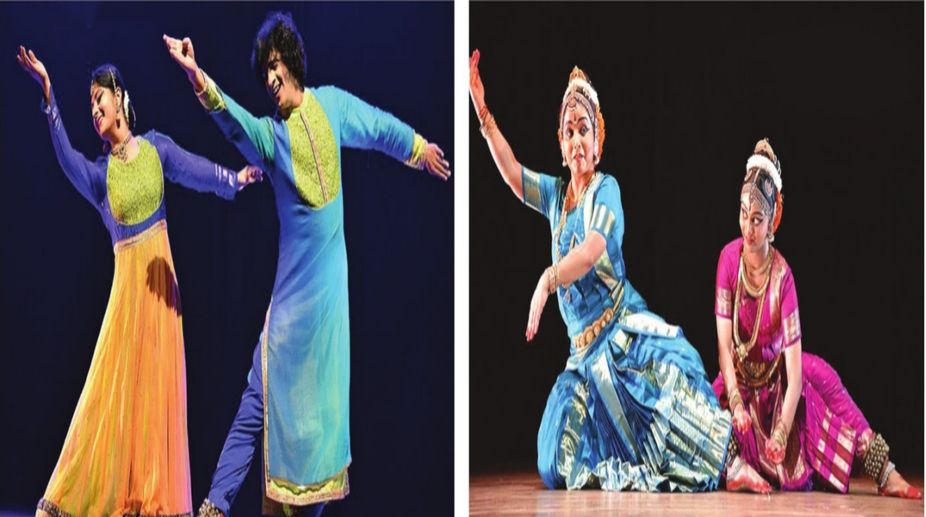Ashimbandhu Bhattacharjee celebrated Ananta in honour of his amma, who was a multifaceted genius but believed in keeping a low profile, influencing many around her in general and her son in particular. Ananta scripted by Amit Dasgupta was a dance drama portraying an endless journey, tracing the Kathaka’s life where, in the end, she emerges as the symbol of universal motherhood. The story of his mother — a disciple of Ustad Bade Ghulam Ali Khan but who lost out as she had to look after a household — was poignantly told. Trained in music by Ustad Bade Ghulam Ali, her life found fulfilment in her son emerging as a well-known Kathak dancer.
Bhattacharjee himself played the role of Ashimbandhu and Ranjani Bhattacharya was the symbolic mother. Through sancharis deftly interwoven with the story, he recreated his life with her masterfully. Through flashbacks, Bhattacharjee recapitulated his childhood days where Imran excelled in the role of a young Ashimbandhu. When dancing was a taboo for boys, his mother stood like a pillar by his side. That was eloquently brought out in the song, Daan haate tor khargo jale, ban haat kare sanka haran, which made her a symbol of the mother land. On the night of Dol Purnima, the choreographer visualised his mother going away to her eternal abode with Narayan following her. Through the refined vocabulary of Kathak and Dinesh Poddar’s light design, the story came alive beautifully.
On the other hand, it was destiny that gave Vaibhav Arekar exposure to Bharatanatyam Margam under discerning mentors like Saroja Srinath, Thangamani Nagrajan and Kanak Rele. His soul’s desire to serve dance with a singular mind was further enhanced by theatre director Chetan Datar, who stood Arekar in good stead. Datar opened a new window for him, thereby changing his vision of dance altogether. From then on, his productions included elements of both theatre and dance without losing the value of either.
With this sensibility in mind, Arekar worked on the theme of a mother-child relationship with the use of Rabindranath Tagore’s poem Debotar grash intermingling it with poems such as Bir Purush and Lukochuri. Theatre taught him the use of space as well as the use of dramatic elements, which he used in bringing out the deep bond between mother and child. When the child in Debotar grash insisted on accompanying his mother on a pilgrimage, the mother, unable to dissuade him, said, “Come let me offer you to the water of the ocean.” Again when the vessel was caught in a storm and Moitra Mahasay, the leader of the group ordered that the child be sacrificed to appease the ocean as promised, the mother earnestly turned to God asking Him, “Did you only hear the words uttered and not the tender ache of a mother’s heart?”
It was a pleasure for Bharatanatyam aficionados to watch Arekar. He scored full marks in the art of storytelling through the medium of Bharatnatyam and theatre. The ocean and other details were shown through the skilful lighting of Sushant Jadav.
Moving on, Nirupama and Rajendra took the Kolkata audience by storm with their Kathak concert. The husband and wife couple struck a cordial note with the audience with their very first presentation of Tarang, creating magic by the sheer beauty of their pure Kathak. Sringar ras was the bhava expressed. The music, consisting of several ragas, was provided by Praveen Godkhindi.
The concluding piece, Nigah was on love and peace. It was a duet composition with a blend of traditional Kathak and modern music, costumes and presentation. Aesthetic enjoyment of beautiful sangeeta (combination of dance and music) was a bit hampered with time taken for the change of costumes.
The Kuchipudi mother-daughter duo of Srimayee Vempatti and Laxmi Vempatti of Guru Vempatti Chinna Satyam Bani presented a traditional Ganesha Kouthwam — a composition of Sri Balamuralikrishna set to Gowlai and Arabhi raga respectively. From Jayadeva’s Gita Govinda they chose to perform a piece showcasing Radha’s pangs of separation from Krishna in raga Malika. Marakata Manimaya, centring on Krishna, was rich in musical content and dealt with madhura bhakti. It ended with a dance on a brass plate displaying mastery over rhythmical footwork. Bimbavati Devi is a thinking choreographer of contemporary times. Her production Nirvak came with a message. Through familiar episodes, Bimbavati Devi pointed a finger at the negative emotions of desire and greed, which have always existed. Nirvak dealt with the realm of the unspoken language. Indian mythology abounds in rich tales involving animals that reveal eternal truths. Nirvak delved deep into the powerful world of animals bringing home messages about the consequences of greed and desire in the vocabulary of classical Manipuri dance, Thang-Ta, Kartal cholam and Pung cholam. She chose matshya (fish), paramhansa (swan), swarnamriga (the golden deer) and mahasimha (lion) to tell her story. It was an unusual but powerful vision, which gave one food for thought besides providing pure entertainment.











